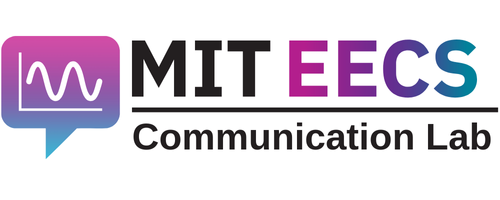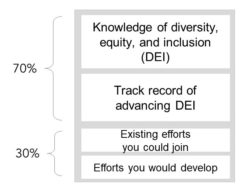Criteria for Success
A successful faculty application diversity statement…
- demonstrates knowledge of challenges related to diversity, equity, and inclusion (DEI).
- outlines your track record of working with diverse groups of people and advancing DEI.
- concretely discusses what you will do as a faculty member to actively encourage DEI and belonging within your group, department, and community.
- follows the instructions provided with the job posting (if applicable).
Structure Diagram
Often, there is a large amount of flexibility on the content and structure of a diversity statement. Section headings are not required or fixed but may be used to help organize the document. In general, a well-structured diversity statement mimics the structure of a teaching statement, showing your knowledge of the topics you choose to discuss, demonstrating a track record of advancing DEI through past experiences, and presenting your future plans around DEI, as shown in the structure diagram below. However, diversity statements may also contain the same content organized topically rather than chronologically. Typically, diversity statements are no longer than 1-2 pages.
Always be sure to follow the instructions in the job posting. It is becoming more common for faculty applications to require a diversity statement as a separate document, but some departments or institutions ask for a combined teaching and diversity statement. Still others will ask for this information to be included in a cover letter or another part of the application.
Identify Your Purpose
A faculty application diversity statement is NOT a document explaining how you as a candidate are diverse. While it is fine to include personal stories if they have informed how you think about diversity, this should not be the main focus of the statement. Rather, a diversity statement is an opportunity to show that you care about the inclusion of many forms of identity in academia and in your field, including but not limited to gender, race/ethnicity, age, nationality, sexual orientation, religion, and ability status.
As such, a diversity statement should not focus on your own experience but rather your intentions as a professor. It should demonstrate that you are familiar with the importance of DEI issues, outline your experience working with diverse groups and advancing DEI, and identify ways that you will use your position as a leader in your field to have an impact within your community.
Analyze Your Audience
Like the other components of a faculty application package, the chief audience for a diversity statement is the faculty search committee. Those most likely to read your diversity statement in detail are search committee members or other faculty who are deeply involved in DEI efforts. With this in mind, keep your statement focused on how you think about DEI, what you have done, and what you will do rather than on providing basic definitions.
Your diversity statement should work in concert with the rest of your application to tell a coherent story about who you are as a researcher and who you will be as a professor. A diversity statement alone is unlikely to get you an interview or a job offer, but a well-written diversity statement may enable you to stand out among a large pool of qualified candidates.
Skills
Demonstrate knowledge of DEI
A diversity statement serves in part to show that the candidate is aware of issues of diversity, equity, and inclusion relevant to a faculty position. Your statement should not read like a paper or textbook on the subject but rather show that you have thought carefully about the ideas, experiences, and intentions that you present. It may be appropriate to acknowledge aspects of your own marginalized identity and/or your own privilege; however, the focus of the statement should remain on what you will do as a faculty member and not on your own experiences.
No statement can address every aspect of diversity, equity, and inclusion, so you may wish to focus on a particular issue or identity that is important to you. However, be careful not to focus your statement solely on one or a few issues at the expense of acknowledging the importance of others. Your statement should demonstrate that you understand that the work of a faculty member involves working with people with a wide variety of identities and experiences.
If you have not spent much time engaging with issues and ideas related to diversity, equity, and inclusion, it’s never too late to start educating yourself. Look for resources that will introduce you to relevant literature and help you learn about people with experiences different than your own. However, remember that it is not the job of members of an underrepresented or marginalized group to educate you on topics related to their experience.
Demonstrate experience with DEI
It is not sufficient to demonstrate knowledge about diversity, equity, and inclusion; your statement should also show experience with them. While this need not be a separate section, your statement should make it clear that you have not only thought about DEI in the abstract but have applied that knowledge and are prepared to continue doing so in the future.
If you are struggling to think of examples that demonstrate your experience, consider your answers to the following questions as a starting point for how you interact with a variety of people in your everyday professional life:
- Who/How do you mentor?
- Who/How do you teach?
- How do you interact with the people around you?
- What experience do you have supporting marginalized groups or individuals (eg, women, underrepresented minorities, first-generation students)?
Be concrete in your future plans
Use an appropriate scale. As a faculty member, you will take on many roles – mentor, manager, teacher, community member – and have more influence than at any point in your career thus far. Your statement should demonstrate how you will use your position as a leader in your field to make a difference in your community. However, the most convincing diversity statement is often not the one that proposes a brand new, large-scale DEI initiative but rather one that suggests concrete, believable actions.
Continue or begin work with already existing initiatives. To do meaningful work towards diversity, equity, and inclusion does not have to mean reinventing the wheel. Consider what you’ve done in the past and what specific DEI issues you are passionate about. Are there organizations that you plan to continue working with? Do some research about what is being done at the institution to which you are applying. Are there groups or programs that you are excited to connect with?
Show, don’t tell. When writing about future goals for advancing DEI, be as concrete, specific, and action-oriented as possible.
| Instead of… | Try… |
| My lab will be inclusive of women. | I will strive for gender parity among my graduate students. |
| I will welcome students of all backgrounds. | I will attend orientation and recruitment events and encourage students from underrepresented backgrounds to join my group. |
| My trainees can turn to me about issues beyond their research and classwork. | I will meet annually with each of my trainees to have career conversations and strive to provide support and resources to help them determine and achieve whatever career goals they have. |
| I will take student feedback seriously. | Carefully reviewing mid-semester course evaluations will allow me to improve my teaching by incorporating student feedback before the end of the semester. |
Organize your statement logically
Choose structure according to content. Usually, you have the flexibility to choose a structure for your diversity statement that best highlights the most important ideas and experiences in your statement. You may choose to follow the explicit structure outlined above – knowledge, experience, and future plans – or you may choose to include these components through a series of themes or examples.
Use full-sentence section headings. To highlight major points in your statement, divide the statement into sections. Make sure each section title tells a clear message.
Use bold or italics to emphasize key points. Use formatting selectively to emphasize takeaways for your reader.
MIT EECS affiliates can make an appointment with a Communication Fellow to obtain feedback on any part of their faculty application package.

